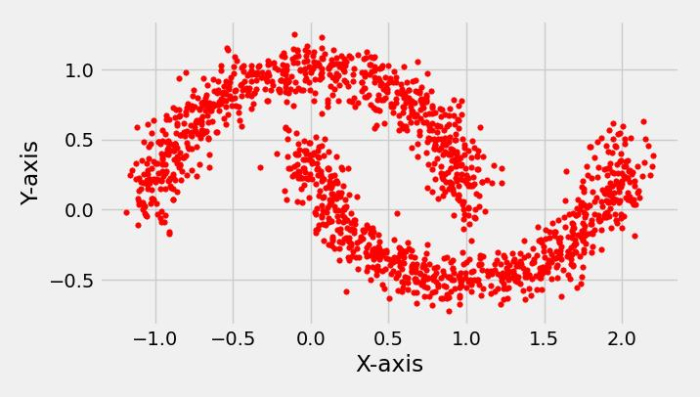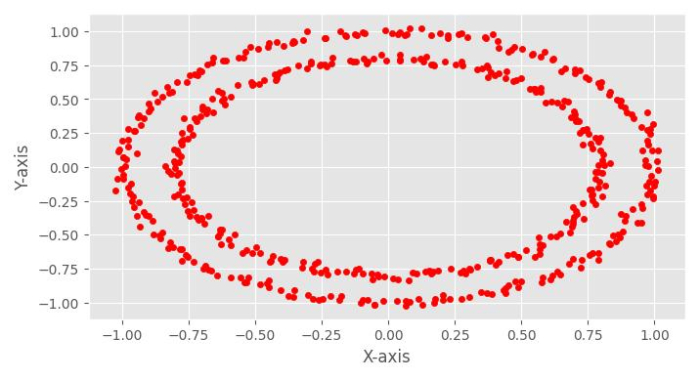如何使用 Python Scikit-learn 建立樣本資料集?
在本教程中,我們將學習如何使用 Python Scikit-learn 建立樣本資料集。
Scikit-learn 有各種內建資料集,我們可以輕鬆地將其用於我們的機器學習模型,但有時我們需要一些玩具資料集。為此,scikit-learn Python 庫為我們提供了一個很棒的樣本資料集生成器。
使用 Scikit-Learn 建立樣本 Blob 資料集
要建立樣本 Blob 資料集,我們需要匯入sklearn.datsets.make_blobs,它非常快速且易於使用。
示例
在下面給出的示例中,讓我們看看如何使用此庫來建立樣本 Blob 資料集。
# Importing libraries from sklearn.datasets import make_blobs # Matplotlib for plotting the dataset blobs from matplotlib import pyplot as plt from matplotlib import style # Set the figure size plt.rcParams["figure.figsize"] = [7.50, 3.50] plt.rcParams["figure.autolayout"] = True # Creating Blob Test Datasets using sklearn.datasets.make_blobs style.use("Solarize_Light2") X, y = make_blobs(n_samples = 500, centers = 3, cluster_std = 1, n_features = 2) plt.scatter(X[:, 0], X[:, 1], s = 20, color = 'red') plt.xlabel("X-axis") plt.ylabel("Y-axis") plt.show()
輸出
它將產生以下輸出:

以上輸出顯示它從 500 個樣本中建立了 3 個 Blob。
使用 Scikit-Learn 建立樣本月牙形資料集
要建立樣本月牙形資料集,我們需要匯入sklearn.datsets.male_moons,它非常快速且易於使用。
示例
在下面給出的示例中,讓我們看看如何使用此庫來建立樣本月牙形資料集。
# Importing libraries from sklearn.datasets import make_moons # Matplotlib for plotting the moon dataset from matplotlib import pyplot as plt from matplotlib import style # Set the figure size plt.rcParams["figure.figsize"] = [7.16, 3.50] plt.rcParams["figure.autolayout"] = True # Creating Moon Test Datasets using sklearn.datasets.make_moon style.use("fivethirtyeight") X, y = make_moons(n_samples = 1500, noise = 0.1) plt.scatter(X[:, 0], X[:, 1], s = 15, color ='red') plt.xlabel("X-axis") plt.ylabel("Y-axis") plt.show()
輸出
它將產生以下輸出

使用 Scikit-Learn 建立樣本圓形資料集
要建立樣本圓形資料集,我們需要匯入 sklearn.datsets.make_circles,它非常快速且易於使用。
示例
在下面給出的示例中,讓我們看看如何使用此庫來建立樣本圓形資料集。
# Importing libraries from sklearn.datasets import make_circles # Matplotlib for plotting the circle dataset from matplotlib import pyplot as plt from matplotlib import style # Set the figure size plt.rcParams["figure.figsize"] = [7.16, 3.50] plt.rcParams["figure.autolayout"] = True # Creating the circle Test Datasets using sklearn.datasets.make_circles style.use("ggplot") X, y = make_circles(n_samples = 500, noise = 0.02) plt.scatter(X[:, 0], X[:, 1], s = 20, color ='red') plt.xlabel("X-axis") plt.ylabel("Y-axis") plt.show()
輸出
它將產生以下輸出:


廣告

 資料結構
資料結構 網路
網路 關係型資料庫管理系統
關係型資料庫管理系統 作業系統
作業系統 Java
Java iOS
iOS HTML
HTML CSS
CSS Android
Android Python
Python C 程式設計
C 程式設計 C++
C++ C#
C# MongoDB
MongoDB MySQL
MySQL Javascript
Javascript PHP
PHP